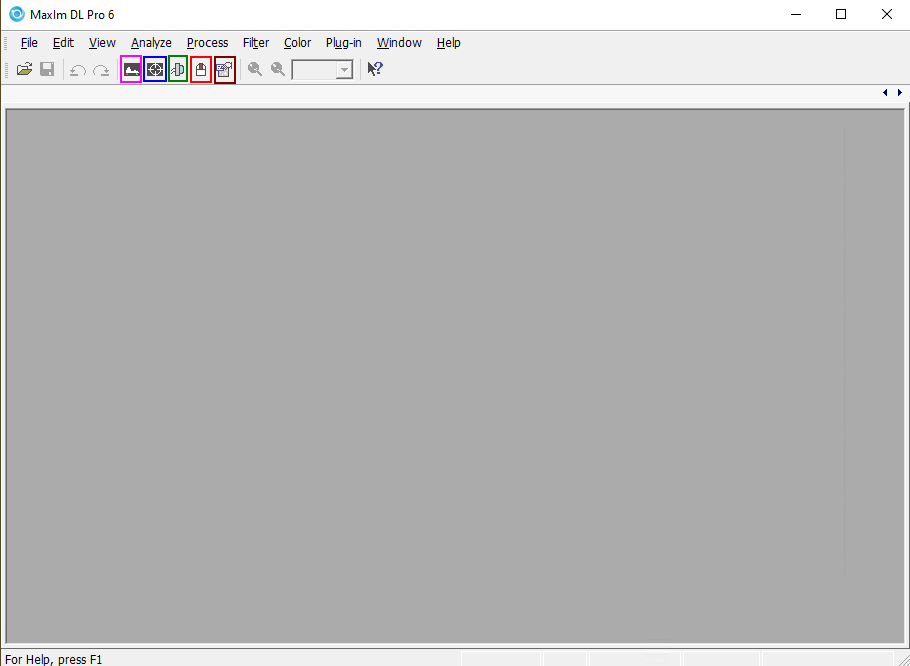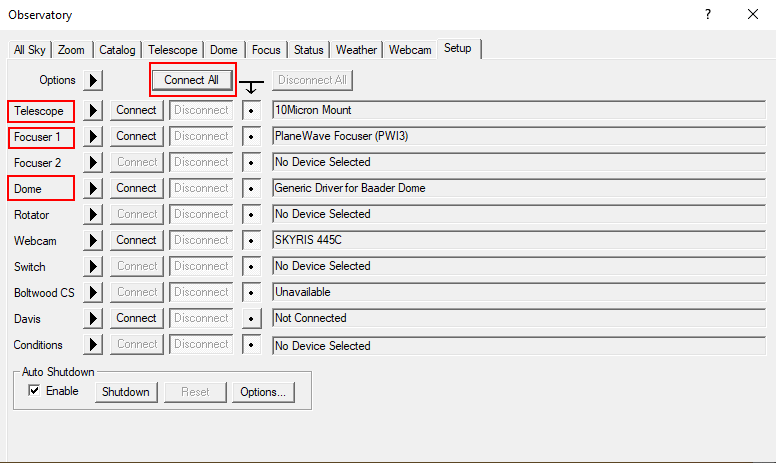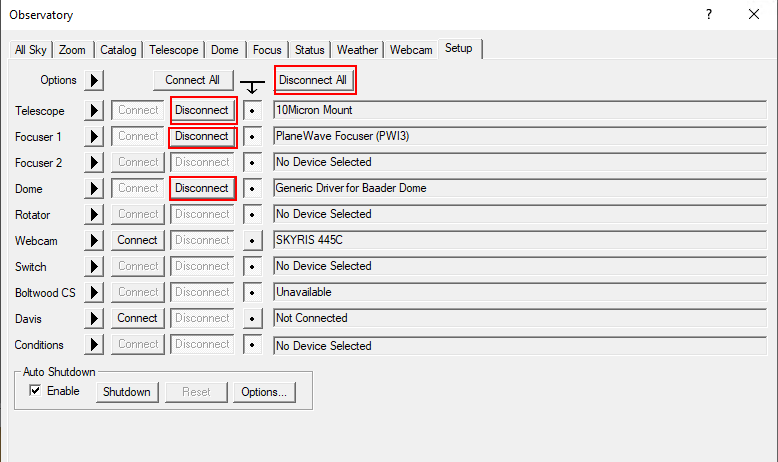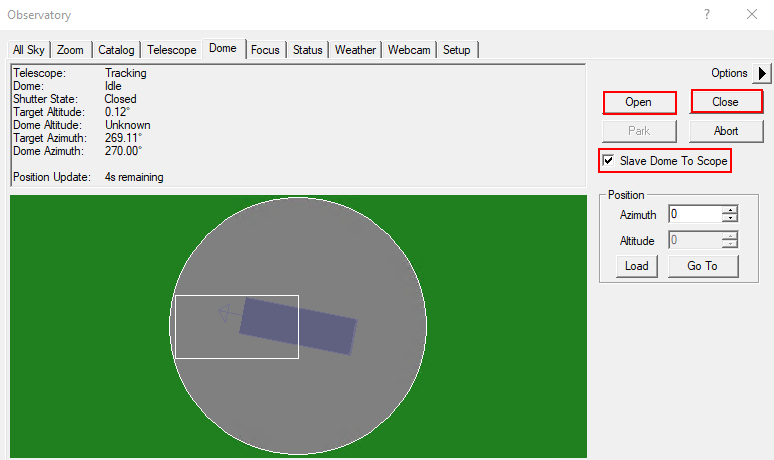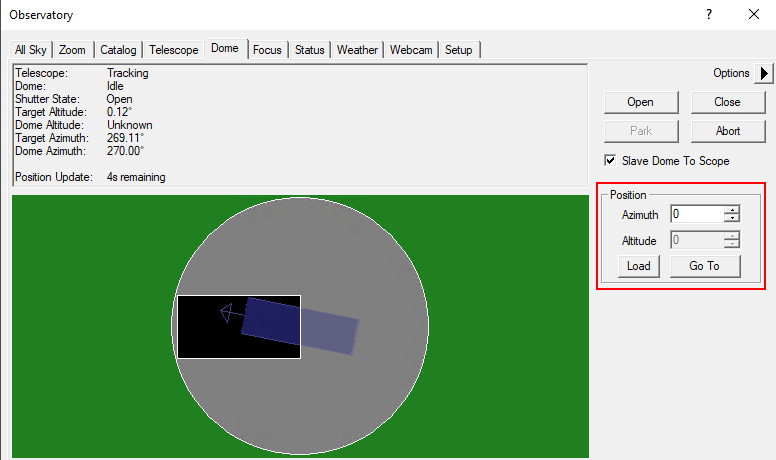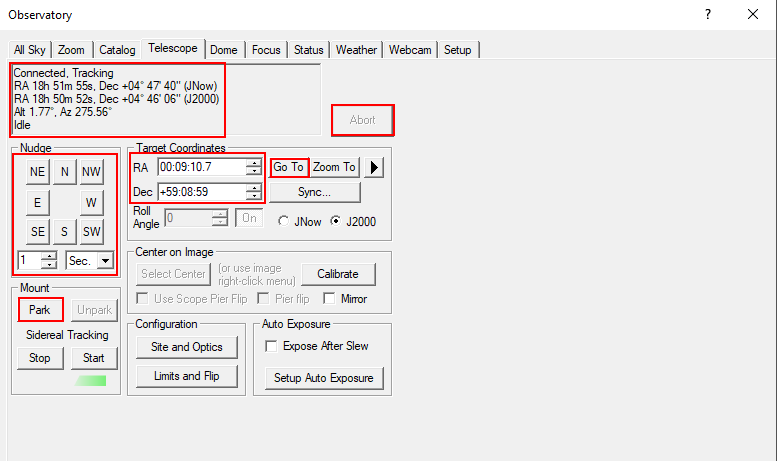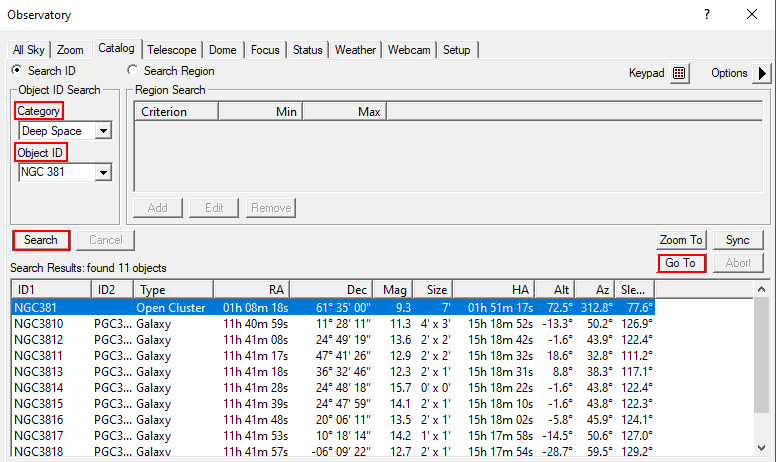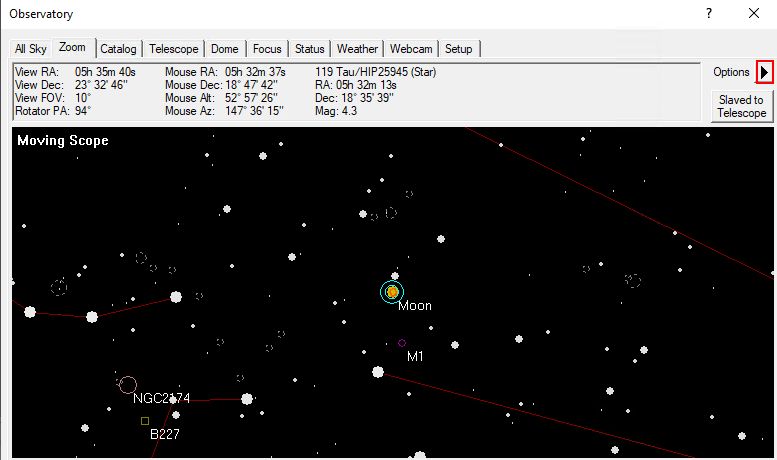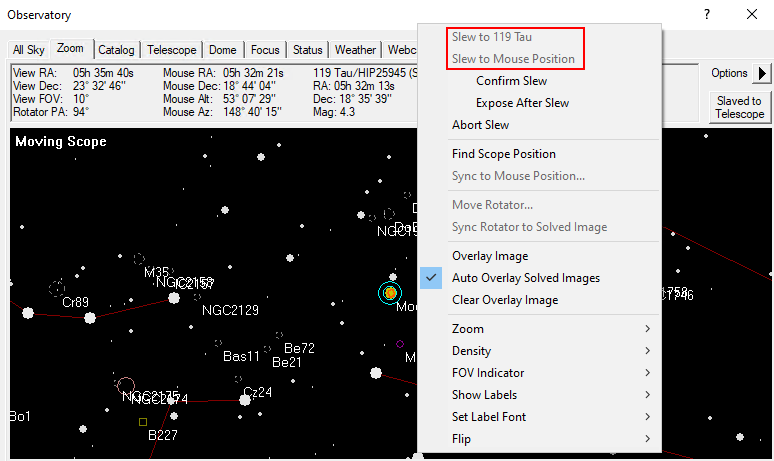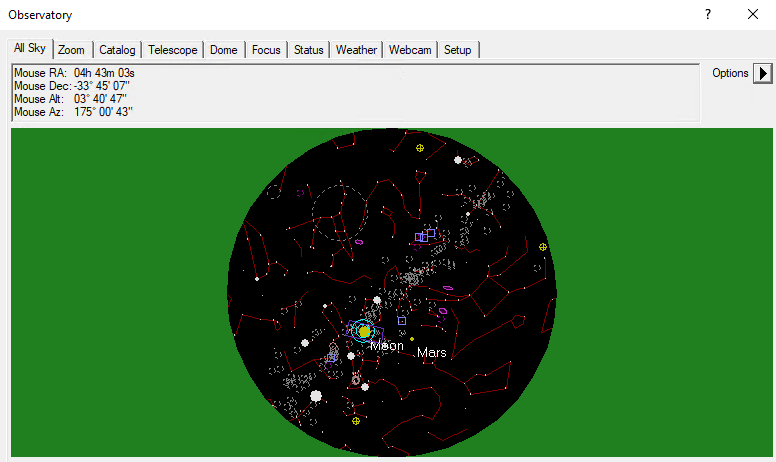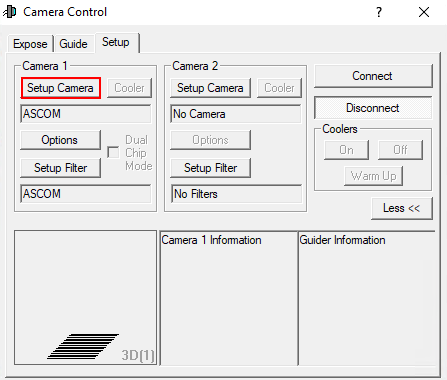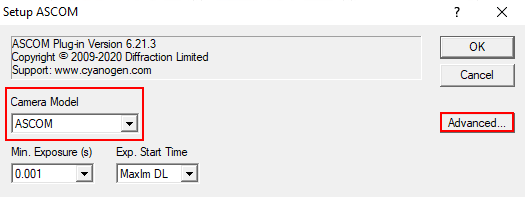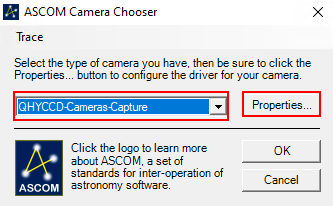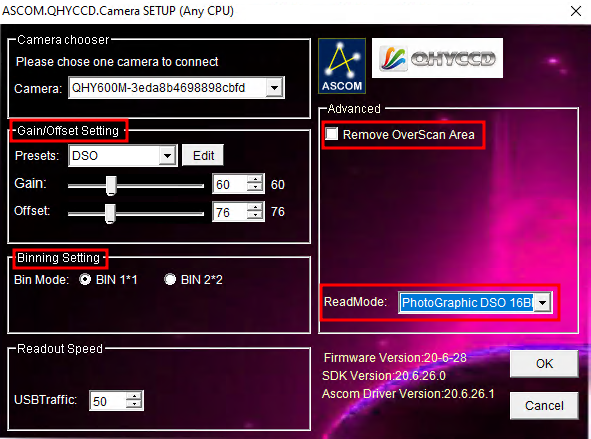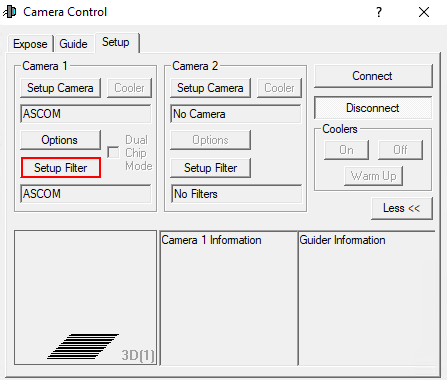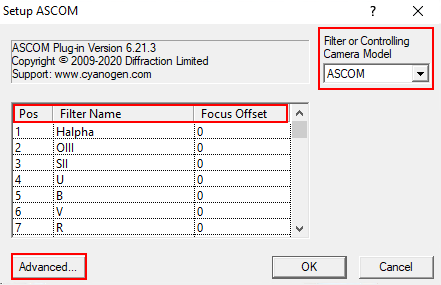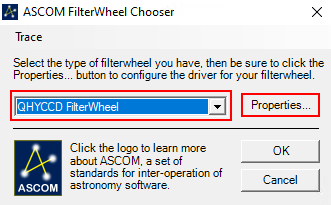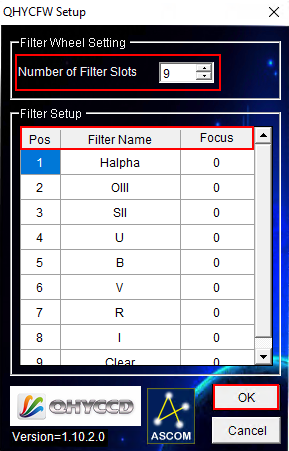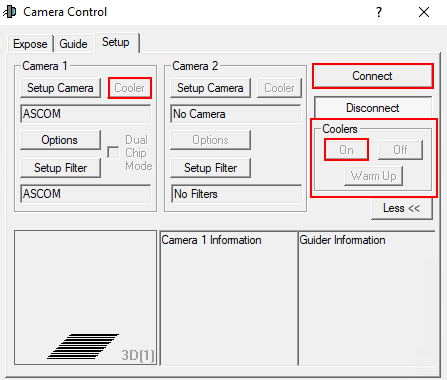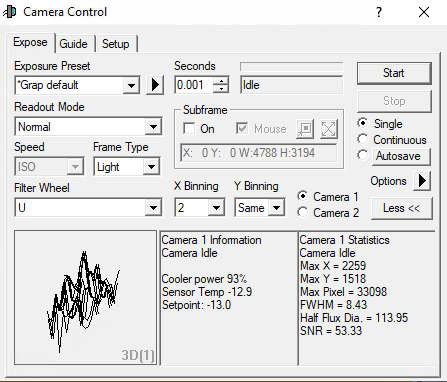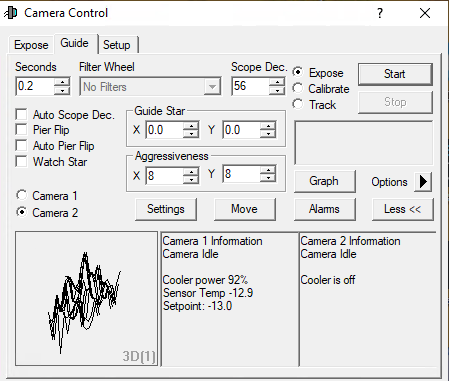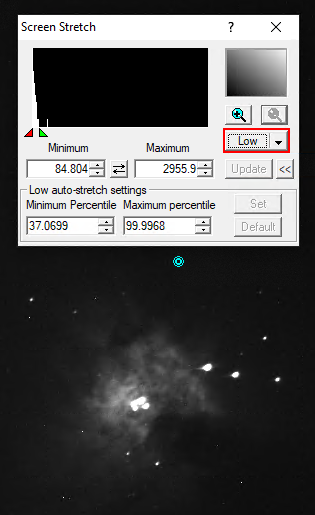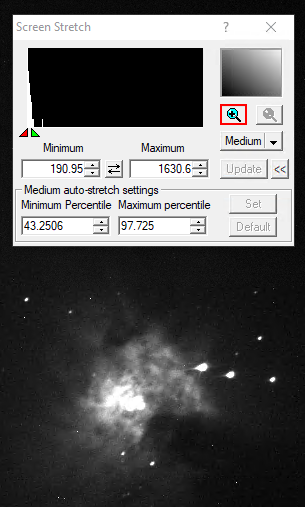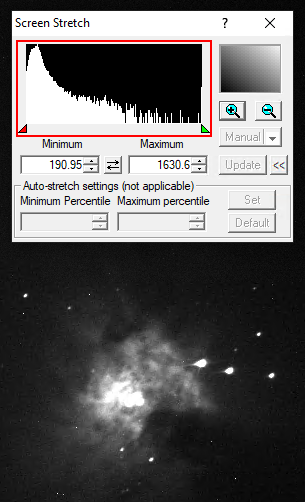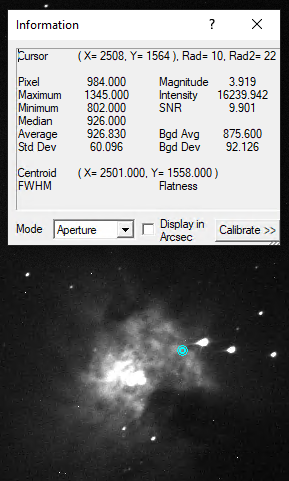This is an old revision of the document!

(remove this paragraph once the translation is finished)
Maxim DL
Maxim DL is currently the main interface for controlling the observatory and cameras as well as for performing the observations.
Interface und grundlegende Bedienung
Maxim DL can be started most easily by double-clicking on the icon Maxim DL 6 on the desktop or via the taskbar.
Main window
In the picture on the left or below, which shows the main window of Maxim DL, the most important buttons are highlighted. The red button opens the Observatory Panel, which contains the controls for the dome and the telescope. The green button opens the Camera Control Panel, which provides the controls for the cameras. These two windows will be discussed in detail below.
The blue, pink, and brown buttons can be used to display information about the captured images. The header information can be called up via the brown button, while the blue button allows, for example, to display the counts in the individual pixels or in a certain aperture. The pink one makes simple image scaling controls accessible.
Observatory Panel
The Observatory control window has different tabs to control the different parts of the observatory. You can move to objects by entering their coordinates, selecting them from a catalog or marking them on an all-sky map. The dome can be opened, closed, and if necessary moved manually. Furthermore, the telescope can be moved manually via this control window and parked again after the observations are finished.
Setup tab
The setup tab is used to establish the connection to the telescope, the dome, and the focuser. You can click on the Connect button behind the respective entry or on Connect All to establish the connection to all components simultaneously. All other entries like Rotator are not relevant for us.
In order to disconnect the devices after the observation, you can click on the individual Disconnect buttons or on Disconnect All.
Dome tab
The Open and Close buttons can be used to open and close the dome. The dome always opens or closes completely. It must be ensured that the Slave Dome To Scope option is activated, otherwise the dome will not follow the telescope. Unfortunately, this option turns off every time the dome is opened, closed, or the telescope is parked.
The dome can be moved manually via the functions in the Position box. This is especially useful when the telescope and the slit are not correctly aligned and the dome needs to be recalibrated. On the example shown above, the alignment is not optimal but still so good that the telescope does not look at the dome.
Telescope tab
The telescope tab shows in the upper left area where the telescope is currently looking and which action it is currently performing. The right ascension and declination are displayed for the current date as well as for the standard epoch J2000. Furthermore, the altitude above the horizon and the azimuth are displayed. In the example shown below, the telescope is tracking and apart from that is inactive.
The buttons in the Nudge section can be used to move the telescope manually, with the step size selected via the drop-down menus. Each movement can again be aborted via the Abort button.
In the Target Coordinates area you can enter the right ascension and declination of an object and slew to it via the Go To button. The Zoom To button switches to the Zoom tab, which displays a map of the sky at the respective coordinates.
The Park button in the Mount area can be used to park the telescope after the observation.
Catalog tab
Using the Catalog tab, the built-in catalogs can be searched for objects. To do this, first select a category from the Category drop-down menu. You can choose between Stars, Deep Space and Solar System. From the drop-down menu Object ID either the object directly or a catalog can be selected. In the latter case the catalog number of the object, or only a part of it, can be entered (see example below). After a click on Search a list of possible objects is displayed. The desired object can be selected from this list. With a click on Go To the object is approached.
Zoom tab
In the zoom tab, the sky map around the selected object is displayed. Via the option button (arrow) on the right and via the context menu, many options are accessible, such as the zoom level. If one clicks with the right mouse button on any point of the map, one can slew the telescope to this point via Slew to Mouse Position. If you click on an object, it can be selected directly. In the example below the corresponding option is Slew tp 119 Tau.
All Sky tab
The All Sky tab shows the current sky. By right-clicking, you can zoom into any area. When you do that you will be redirected to the zoom tab. The option button (arrow) on the right provides access to many setting options.
Camera Panel
The Camera Control window can be used to control the cameras and take the images.
Setup tab
As the name suggests, this window is used to connect the cameras to Maxim DL. This is done slightly differently for each camera manufacturer. Here, we will discuss the procedure for QHYCCD cameras and for SBIG cameras, since these are the cameras we primarily use. For each camera model, the appropriate driver must be selected. This must be done for the actual camera as well as for the filter wheel. If a guiding camera is to be used, it must also be connected here. Normally the guiding camera is connected as Camera 2, while the main camera is connected as Camera 1.
The first thing to do, regardless of the manufacturer, is to click on Setup Camera.
Connecting QHYCCD cameras:
In the window that opens, select ASCOM from the Camera Model drop-down menu and then click Advanced… (step 1). After that another window will open. In this window, select QHYCCD-Cameras-Capture from the dropdown menu and click on Properties… (step 2). After that, the settings menu for the ASCOM driver for the QHYCCD cameras opens. ASCOM is the basic interface through which many of the observatory's operations are controlled.
In the last step (3) all important settings for the ASCOM driver can now be configured. These include the readout mode, which can be selected from the ReadMode drop-down menu. The following can be selected: PhotoGraphic DSO 16bit, High Gain Mode 16bit, Extend Fullwell Mode and Extend Fullwell 2CMS. Under Gain/Offset Setting the Gain and Offset can then be set. These settings can be saved as Preset. In addition, the Remove Overscan Area option should also be activated for scientific images. Afterwards, all three windows can be closed by clicking OK.
Connecting QHYCCD filter wheels:
To connect a filter wheel, first click on Setup Filter.
In the first step you have to select ASCOM from the dropdown menu Filter or Controlling Camera Model. Then click on Advanced…. In the window that opens, select QHYCCD FilterWheel from the drop-down menu and then click Properties… (step 2). Thereupon another window opens, which shows the possible driver settings. The settings in this window usually have to be made only once. You have to select the Number of Filter Slots (in our case 9) and the respective filter names as well as any corrections for the focus (step 3). Afterwards all three windows have to be confirmed and closed by clicking OK.
Connecting SBIG cameras:
Still to come…
Connecting SBIG filter wheels:
Still to come…
Final Step:
Now Connect has to be clicked. Then the cooling can be activated under Coolers and the target temperature can be set under Cooler.
Expose tab
In diesem Tab findet man, auf kleinem Raum, die wichtigsten Einstellung rund um die Aufnahme der Bilder. Eigene und bereits vordefinierte Einstellungssets können unter Exposure Preset gefunden bzw. neu angelegt werden. Die wichtigste Einstellung ist die Belichtungszeit (Seconds). Rechts daneben findet sich die Statusinformationszeile, welche anzeigt was die Kamera aktuell tut. Im unteren Beispiel ist die Kamera inaktiv (Idle).
Die Filter sind unter Filter Wheel zu finden. Die Binning-Optionen sind wiederum über die beiden Dropdown-Menüs X Binning und Y Binning zugänglich. Des Weiteren kann der Auslesemodus (Readout Mode) ausgewählt werde, was z. B. für die QHY600M wichtig ist. Über die Optionen Single, Continuous und Autosave sind als grundlegenden Modi auswählbar. Beim ersten wird nur eine einzelne Aufnahme angefertigt, wohingegen beim letzten ganze Aufnahmeserien erstellt werden können. Beim Modus Continuous werden hintereinander Aufnahmen mit der eingestellten Belichtungszeit erstellt und dargestellt. Dieser Modus eignet sich besonders gut zum Fokussieren. In dem entsprechenden Artikel gehen wir auch genauer auf die unteren 3 Paneele ein. Weitere Optionen sind noch über Options (Pfeilbutton) zugänglich.
Guide tab
Der Guide-Tab wiederum hält die wichtigsten Einstellungen für das Guiding des Teleskops bereit. Auf die Details gehen wir in einer Kurzanleitung zum Guiding ein.
Screen Stretch Panel
Über das Screen Stretch Panel kann die Skalierung der Aufnahmen beeinflusst werden. Im ersten Beispiel unten, welches M42 zeigt, ist die Skalierung auf Low gestellt. Erhöht man die Skalierung auf Medium werden deutlich mehr Details von M42 sichtbar. Viele weitere hilfreiche vordefinierte Skalierungen können aus dem entsprechenden Dropdown-Menü ausgewählt werden.
Klickt man auf das Plus-Symbol im oberen rechten Bereich, wird in das oben links dargestellte Histogramm gezoomt. Dies ermöglicht es die Skalierung über das rote und das grüne Dreieck feiner einzustellen, wobei das rote Dreieck den Schwarzwert und das grüne Dreieck des Weißwert definiert. Entsprechendes kann auch über die Felder Minimum und Maximum erfolgen.
Information Panel
Das Information Panel ist insbesondere hilfreich um zu prüfen, ob das Bild überbelichtet ist und herauszufinden an welchen Sternen dies unter Umständen liegt. Hier sind für uns insbesondere die Werte Pixel und Maximum interessant. Im Standardmodus Aperture werden die Informationen aus der auf dem Bild dargestellten türkisen Apertur ausgelesen, welche man z.B. aber auch auf einen hellen Stern schieben kann. Tut man dies sind z.B. noch das Signal-Rausch-Verhältnis (SNR) und die Full-Width-Half-Maximum (FWHM) von Interesse. Werte wie die Magnitude sind auf unseren zumeist unkalibrierten Bildern nicht von Relevanz.

